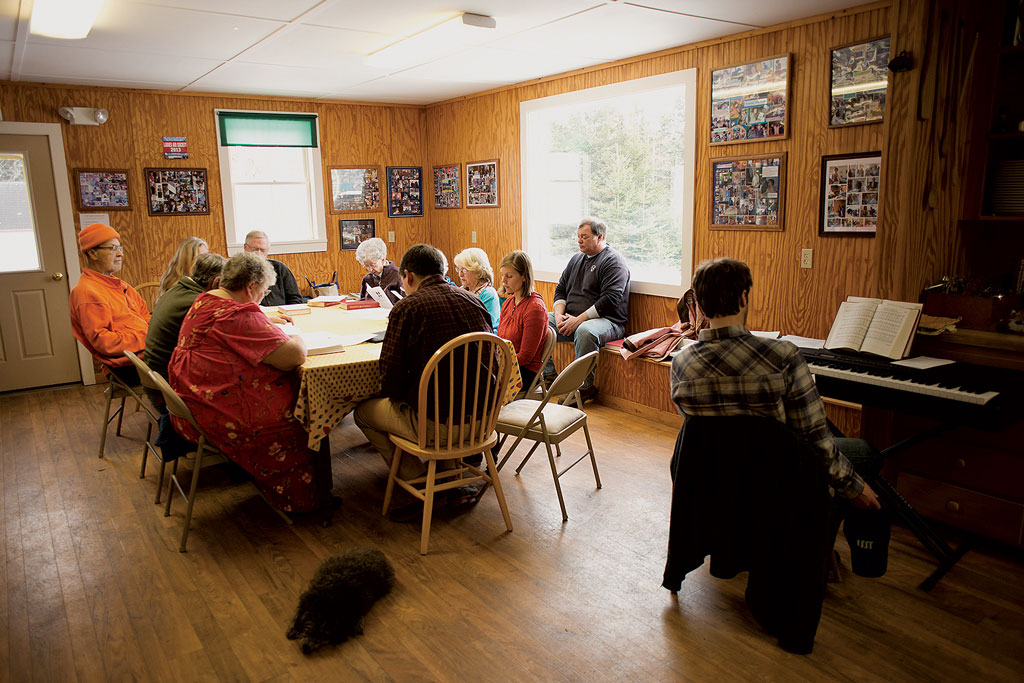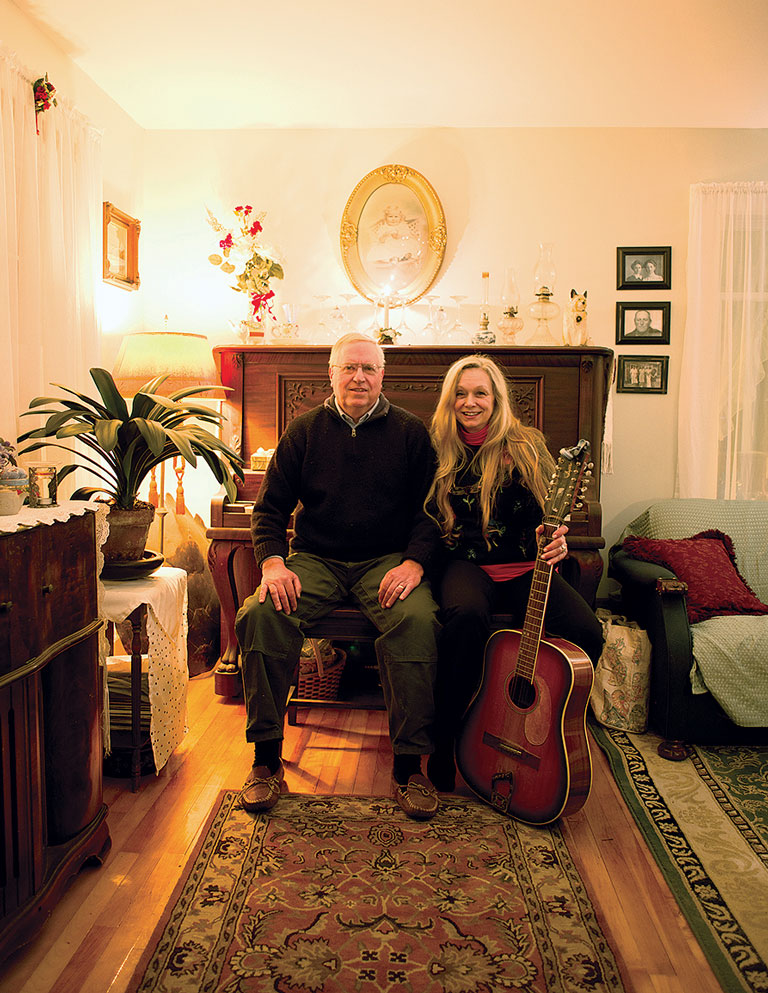Islesford and Great Cranberry Island face the Atlantic — and the future — side by side.
By Virginia M. Wright / Photographed by Douglas Merriam
Wilfred Bunker and Elmer Spurling were two of the best boat captains the Cranberry Isles have ever produced. They were also rivals, whose competition for the lucrative mailboat contract divided them much the way the mile-wide channel known as The Gut separates the islands each man called home. During one late-winter northeaster, Spurling, an Islesford man, steered his lobsterboat across that passage to Great Cranberry Island and picked up his sometime adversary, one of the few people he could trust to help with a grim and dangerous task: retrieving the body of lobsterman Roland Sprague from a wave-battered beach in Blue Hill Bay.
Hours earlier, the Coast Guard had found Sprague and his sternman, Fred Fernald, frozen to death in their lobsterboat, which had run aground on Pond Island, some 10 miles from where they had last been seen moving traps in preparation for the storm. The guardsmen managed to bring Fernald’s body onto their vessel, but with the gale bearing down, they were ordered to leave Sprague behind.

By the time Spurling, Bunker, and their crew arrived at Pond Island, it was dark, and Sprague’s body was nowhere to be seen. Sweeping a searchlight over the black swells, the seamen saw a man’s knee break the surface. Working quickly, they pulled the body from the deep. Then they brought Roland Sprague home.
It’s my third day on the Cranberry Isles, and I’ve heard this story in varying detail four times. This time the storyteller is Wilfred Bunker’s niece, Eileen Richards, who presides over the diminutive Great Cranberry post office on Spurling Cove, where a picture window is the only thing that stands between her and storm-tossed waves. (“I tell people this is the only post office in America equipped with a life jacket,” she jokes.) Fifty-five years have passed since Elmer Spurling and Wilfred Bunker put aside their differences to bring some sense of resolution to a widow and her two young children, but here on the Cranberry Isles, where the Bunkers still run the mailboat, and where Spurlings and Spragues and Fernalds abound, it can seem like only yesterday.

The story especially resonates on this bitterly cold Monday after the town meeting weekend. For months, the tension had been building between Great Cranberry and Islesford. The issue: whether to make $610,000 in repairs and improvements to Great Cranberry’s Longfellow School — a school no child had attended since 2000 and a school no child will ever attend again unless the building, which also houses the public library, is brought up to code. With just 10 schoolchildren between the two islands, all enrolled in the Ashley Bryan School on Islesford, some budget-minded folks from that smaller but more populous isle had deemed the proposal wasteful. To the Great Cranberry islanders, giving up on the school was tantamount to a death sentence. Failure to restore it, they believed, would doom the year-round community, whose population hovers around 40.
On the morning of the town meeting, nearly every resident of Great Cranberry — along with some seasonal residents who’d traveled hundreds of miles for this vote — boarded the ferry for Islesford, primed for battle. Gathering in the Neighborhood House, a rustic meetinghouse with a hand-painted mural depicting the islands’ spectacular view of the mountains of Acadia National Park, nearly two dozen people from both sides of The Gut gave testimony. Eileen Richards was one of them. She said that Wilfred Bunker, “a man who served this community in many ways, a friend and relative to most of us,” had been on her mind, and she wondered what he would have to say about all of this. “This item is not about money. It is not about winning, as winning implies an opponent, and I hope my friends, neighbors, and relatives do not look at me as the enemy. I am you, only I live on a different island.”
She and her fellow Great Cranberry islanders needn’t have doubted their Islesford neighbors. The measure to restore the school passed easily, 64 to 20.

At the turn of the 20th century, 300 of Maine’s 3,000-plus coastal islands hosted thriving year-round communities; today, Great Cranberry and Islesford are two of just 15 true island communities left. Along with Baker, Bear, and Sutton islands — each host to a smattering of summer homes — they compose the town of Cranberry Isles, served year-round by the Beal & Bunker mailboat, a passenger-only ferry based in Mount Desert Island’s Southwest Harbor, about three miles away.
In summer, the islands have a peaceful, languid air that contrasts sharply with the bustle of MDI and Acadia National Park, which see 2 million visitors a year. Islesford (the island’s name is actually Little Cranberry, but everyone who lives there calls it by the name of its village, Islesford) is the busier of the two, receiving a handful of small tour boats whose passengers stroll up the road to the village, snapping photos of the stacks of lobster traps, then spend an hour or two learning about island life at the national park museum or cracking lobsters at the Islesford Dock Restaurant before heading back to the mainland. Great Cranberry has its attractions, too, but they require a bit more effort to find — about half a mile from the town dock, there’s Cranberry House, with a café, art gallery, and history museum, and about a half-mile beyond that, there’s Polly Bunker’s Whale’s Rib gift shop. Auto traffic on both islands is almost nil.
Winter is even quieter — and it can be achingly lonely. Islesford’s population shrinks from 300 to 70, Great Cranberry’s from 250 to 40. The restaurants, museums, galleries, and shops close. The mailboat cuts its trips to four a day; the tour boats don’t run at all. The miles to the mainland — and between the two communities — seem to grow.

“It’s surprising the distance The Gut can produce,” Tom Powell, pastor of the Great Cranberry Island Congregational Church and the Islesford Congregational Church, tells me. “Being two islands inherently means there are two distinct communities. It’s like the difference between a village and a long country road. Islesford is the village; the houses are near each other, and business and pleasure necessarily involve exchanges with your neighbors. Activities are impromptu. Great Cranberry is the long country road; there’s a trunk with some branches, and the houses are spread out along it. There’s a sense of community, but it has a different flavor. You have to make activities, because that’s how you get together.”
Powell and I are seated in the living room of the parsonage on Great Cranberry, where he and his wife, Becca, have offered me the use of their guest room, since there is no lodging on the islands this time of year. The couple is one of the reasons I’ve come: just six months into his job when we meet, Powell, 33, is the islands’ first resident minister since 1951.
Tom and Becca Powell
The decision to hire a pastor — initiated by Great Cranberry parishioners, who then enlisted the support of their counterparts on Islesford — was as much symbolic as it was spiritual. “An island’s identity is wrapped up in its sense of community,” Powell explains. “There’s a postmaster, there are children in the school, there are people in the library, there’s a minister in the church. These things say ‘We are.’ For a lot of people, whether they go to church or not, knowing that I’m here is representation that the islands are looking forward with an optimism. They have a future.”
The sense of vulnerability is keenest on Great Cranberry. Its population is not only smaller, it’s older, with a median age of 58 compared to Islesford’s 41. Its once-vibrant fishing community today numbers just two lobstermen. By contrast, Islesford, home to the Cranberry Isles Fishermen’s Co-op, counts 22. Other work on both islands — carpentry, landscaping, and the like — is spotty once the summer people depart.
Such realities fueled the anxiety surrounding the Longfellow School project, Powell believes. “Have you ever met someone who has a negative self-image? I think there is some of that on this island. The question about the school created an existential crisis, and the island’s unspoken negative self-image was expressed in fear and doubt. The thinking was that Islesford would see it only as dollars and cents. They didn’t — but then again, who knows how it would have gone if people hadn’t been so motivated?”

Powell grew up in Pennsylvania and spent summers on the island of Vinalhaven, in Penobscot Bay, so he had some idea of what he was getting into when he applied for the post of pastor. Indeed, he says, it is exactly what he and Becca were looking for. “It’s traditional for small parishes to be starter churches, but I don’t view this that way. It’s a three-year contract, but I hope it lasts far longer. We’ve put all our chips in. This isn’t parsonage furniture in this house; it’s our furniture. We could have left it in storage in Bangor. This is our home. This is our place.”
On the Sunday morning after the town meeting, 10 people — a good turnout for winter — gather around a table in Great Cranberry’s unofficial winter church, the Ladies Aid building, which, unlike the actual church, has the luxury of heat. Powell says prayers for ill members of the community and reads his sermon from an iPad, and the group shares a potluck lunch. Then the Powells dash to catch the mailboat to Islesford, where Tom delivers another sermon, and because the ferry will have made its last run by the time they’re finished visiting, the couple spends the night in a parishioner’s home. Powell is a Presbyterian, but he says, “I’m a broad churchman here. Both of these islands exist as a parish — as a local church for the people who are here. You’re really their only option. In many ways, it’s the way it used to be when people had to walk to church, or ride a horse.” On paper, his is a part-time mission; in practice, he works nearly every day, visiting shut-ins, offering comfort to the sick, and organizing volunteers for community work and activities. He makes the trip across The Gut at least once a day, often more, and making that connection, he says, is one of the most important things he does. “Part of my job,” he believes, “is knitting the islands together.”
Powell’s ability to appeal to a broad spectrum of church-goers, his musical talent (he plays the piano and sings), and his and Becca’s genuine interest in island life made him the unanimous choice of the churches’ hiring committee, member Phil Whitney tells me after the Great Cranberry service. “We were leaning toward younger people if they were mature enough to deal with older people, because we thought they would add enthusiasm and vitality to the community above and beyond the church,” Whitney says. “And that has happened. Rebecca and Tom are filling a void. Becca is on the planning board. Both help out at Cranberry House. Both are in the fire department. With the fire department especially, having two more bodies getting training is extremely important. When you get involved in just a few things out here, you can’t help but make a big difference.”
Few people have done more to try to reverse the exodus of the Cranberries’ population than Whitney, who grew up in Southwest Harbor and has roots on Great Cranberry stretching to the late 1700s. After a globetrotting career with the U.S. Department of State, he retired with his wife Karin to the island in 2001, moving into his grandparents’ house, which he’d frequented as a child. “I didn’t want to see what I loved, what my grandparents and generations of my family and other families built, disappear,” he says. “A malaise was settling in, and there didn’t seem to be a lot of motivation to turn things around. The attitude, especially in winter, seemed to be that the handwriting was on the wall and people were waiting for the island to die.”

He and Karin plunged in. As a selectman, he helped establish a town-subsidized commuter boat whose early morning and evening runs allow people to have full-time jobs on the mainland. He joined the historical society, which purchased and renovated the Cranberry House building. Karin runs the seasonal café, Hitty’s, named for a doll in a 1929 children’s novel by the late Rachel Field, a summer resident of Sutton Island. Phil is president of Cranberry Isles Reality Trust (CIRT), an affordable workforce organization that has acquired or built five rental homes, four of them on Great Cranberry.
“We talk to a lot of people who come through our doors,” Whitney says of would-be CIRT tenants. “Some of them say it’s a wonderful place, they’d like to live here, and you can tell right off the bat that they wouldn’t make it here in January. But there are others who seem to understand the issues of living on the frontier, as I call it, living on the edge of the open ocean in winter. The people you try to persuade are those you think are going to make it economically and socially. It’s a narrow section of the population that can be out here in winter without ready hospital access or a drug store or a movie theater.”
Every morning, Richard Beal opens the Cranberry General Store – the only commercial enterprise on Great Cranberry that keeps hours in winter — and takes his chair by the front window, where he plays host to regulars who stop in for coffee, politics, and gossip. It is not Beal’s store, but the key is entrusted to him by Janice Murch, a summer resident who bought the place in 2009 and who, I am told by several people, keeps it open in winter even though it loses money because she wants to support the year-round community. (When I caught up with Murch last summer, she declined to speak on the record, but suffice it to say she holds the island and islanders dear.) Located a few paces uphill from the town dock, the store stocks the basics and a surprising amount more — cereals, cheeses, pastas and sauces, frozen pizza, and other items that can be cobbled into a nourishing meal should one’s refrigerator go empty before a trip to the mainland supermarket.
“I’ll run down and unlock the store after hours if someone is having a problem — that’s normally with cigarettes. There are people on Islesford who call over here to have cigarettes put on the mailboat,” says Beal, a selectman and retired Navy captain who has called Great Cranberry home since 1998. “We have beer and wine, but no hard liquor. Not that we haven’t tried. Two years ago I wrote a warrant article and tried to change that, but nope, they don’t want it. I’ve learned a lot in 16 years, and there are some things they just won’t do. They don’t want five selectmen — nope, we’ll stick with three. They don’t want nominations for selectmen five months in advance — nope, we want them from the town-meeting floor. They don’t want a town manager — nope, they’ll get too much power.”

The school vote is the topic this Monday morning, as roughly one-third of the town wanders into the store in the space of an hour. There’s Malcolm Donald, a lifelong seasonal resident who came up from Portland for the meeting; Polly Bunker, who never goes to Islesford (the steep dock stairs challenge her 87-year-old legs), but was compelled to go this time and be counted; Eileen Richards, who is on her way to open the post office; Eileen’s brother, Blair Colby, whose collection of used trucks makes him Great Cranberry’s de facto public works department; the Powells, who have just come off the ferry from Islesford; and Annie Alley, who, though ailing from cancer, adds her freshly baked toll house cookies and mini cheesecakes to the bakery shelf. (Both Donald, 74, and Alley, 81, have since passed away.)
One of the store’s most popular items is a tee-shirt, bearing a slogan coined by Polly Bunker’s sister, the late Charlene Allen: You Can Get a Pound of Butter and Everything Else You Need to Know. Another way to put it: this is no place for a recluse.
“You don’t live on an island unless you want to be part of the community,” Pastor Powell tells me later. “This is a wonderful community, but it’s not perfect. It isn’t Mayberry. There are people who are broken. There are people who go home and drink. Those people are in every town; the only difference here is, you can’t hide from that. You know their names. Some people may not want that, but for others, it meets a need for belonging. And because there’s that frailty, you’re free to not be perfect and you won’t be ostracized.”

There are some encouraging signs for the islands’ future. This past summer, two families with four children between them moved into CIRT houses on Great Cranberry, thus increasing the school population by almost half and bolstering islanders’ argument for using the Ashley Bryan and Longfellow schools on an alternating schedule.
Meanwhile, Great Cranberry’s two boatyards are being reinvigorated by two young men with Cranberry roots. Josh Gray, who graduated from Colby College in 2005 and spent some time working in Washington, D.C., now lives on Islesford and commutes daily across The Gut to Newman and Gray Boatyard, a business co-founded by his father 30 years ago. The company has six year-round employees. Sam Donald — Malcolm Donald’s son — pursued careers in finance in New York and international development in Washington and Cameroon, but now he is living on Great Cranberry, managing Cranberry Island Boatyard, which has two year-round employees. “My relationship to this place goes way back to high school, when I worked here summers,” Donald says. “In the back of my mind, I always thought that this was the job I most enjoyed. It’s been much easier to be out here than I thought. I expected to feel isolated and lonely and to go stir crazy, but it hasn’t been that way at all.”

When I was young, I was told my father was lost at sea,” Joy Sprague says. “That’s why I loved walking the beach, because if he was lost, then that meant I could find him.”
It is a balmy summer day on Islesford — five months after the town meeting — and I am sitting with Sprague and lobsterman Stefanie Alley at a picnic table in a field overlooking The Gut and Great Cranberry beyond. Sprague tells me she was just 3 when her father died in his lobsterboat during that late-winter northeaster in 1959. As the years passed, she would learn how two rival sea captains had recovered her father’s body, an act that not only gave her mother some measure of peace, but also financial security: had there been no body, Roland Sprague’s widow would have had to wait seven years to collect her husband’s Social Security benefits. “My mother was from Virginia, and she had only been living here a few months when he died,” Sprague says. “She could have gone back home to her family, but she loved this community, and she did everything to keep the pieces together so we could stay.”
Sprague is the Islesford postmaster, a position she has held since she turned 21, when she was briefly the youngest postmaster in the country. Each year, she and Eileen Richards, her friend and counterpart on the other side of The Gut, compete to sell the most stamps by mail, a contest that gives both post offices an income boost. She worked with Phil Whitney on the committee that hired Tom Powell to serve as pastor of the Great Cranberry and Islesford churches. She also is a selectman — nominated from the floor at the town meeting, she edged out Whitney, 38–36.
Which leads to one last story, one that Joy Sprague says not many people know. Not long before Elmer Spurling died in 1984 at the age of 83, Sprague saw him and his wife, Eleanor, sitting on the mailboat, which was picking up passengers at the dock. His old competitor for the mailboat contract, Wilfred Bunker, then in his 60s, was at the wheel. “It’s Saturday morning, the 11 o’clock boat,” Sprague recalls. “Wilfred goes and talks to Elmer. Elmer plants his cane, stands up, and goes to the steering wheel.” Sprague’s voice cracks. “And Elmer pilots that boat. Wilfred sits there, biding his time. Wilfred showed that he respected Elmer and trusted him with his boat. It was better than a handshake.”
In a small island town, sometimes your friends and your rivals are one and the same.

